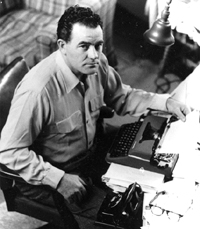Thursday, July 26, 2012
Bookish Nerd Bait: Vol 6
Wednesday, July 25, 2012
Tuesday, July 24, 2012
Bookish Nerd Bait: Vol 4
Monday, July 23, 2012
Bookish Nerd Bait: Vol 3
Friday, July 20, 2012
What is Oulipo?
Glad
you asked. It’s an interesting concept. According to Wikipedia:
Oulipo (short for French: Ouvroir de littérature potentielle; roughly translated: "workshop of potential literature") is a loose gathering of mainly French-speaking writers and mathematicians which seeks to create works using constrained writing techniques. It was founded in 1960 by Raymond Queneau and François Le Lionnais. Other notable members have included novelists Georges Perec and Italo Calvino, poets Oskar Pastior, Jean Lescure and poet/mathematician Jacques Roubaud.
The group defines the term littérature potentielle as (rough translation): "the seeking of new structures and patterns which may be used by writers in any way they enjoy."
Constraints are used as a means of triggering ideas and inspiration, most notably Perec's "story-making machine", which he used in the construction of Life: A User's Manual. As well as established techniques, such as lipograms (Perec's novel A Void ) and palindromes, the group devises new techniques, often based on mathematical problems, such as the Knight's Tour of the chess-board and permutations.
What
do they mean by “constrained writing techniques” exactly? Well, Perec’s novel A Void,
for example, is a three hundred page book constructed entirely without
the letter ‘e.’ I don’t know if I could write a blog post without the letter ‘e,’
let alone a whole freaking book. That’s pretty amazing. The question is, is it
any good?
They
also use other constraints like palindromes- the most famous of which is the old “Lisa Bonet ate no basil” line, which appears exactly the same whether
you read it backwards or forwards. But they get much longer than that one.
I’d
be interested in learning more about Oulipo. But while you consider whether or
not to join me in my curiosity, take a look at the winners of this contest put
on by the Outlet. The constraint they imposed was to write a story where no
single word could be used more than once- not ‘and,’ not ‘the,’ not 'a,' not anything. Go ahead and read the winners. They’re
all pretty short, but it’s interesting to see what people came back with. (Warning,
some language in the first two- they seem to have been picked for their edginess. But the third is pretty impressive for its
length and the story it tells.)
Oulipo!
Thursday, July 19, 2012
At The Bindary
Yesterday's videos raised a specter from my own past: this catchy little diddy from a Reading Rainbow episode I haven't seen in twenty years, but whose words I could have sung to you even without YouTube's assistance. Enjoy:
Wednesday, July 18, 2012
We've come a long way, baby...
I came across this time capsule of a video on the Paris Review Daily:
Pretty interesting, right? Makes this next video even more impressive:
And seeing them side-by-side reminds me of this classic, demotivational poster:
Tuesday, July 17, 2012
More on Little Blue Books
Alright. I imagine some of you may have turned your noses up at yesterday’s post simply because you can’t appreciate the awesomeness that is Louis L’Amour. (Now there’s a writer who deserves a post of his own if I’m ever to make a clean breast of my earliest reading influences). But it got me thinking about the Little Blue Books publishing line that he mentions. It turns out L’Amour is far from the only author to remember the series fondly. Here’s more from Wikipedia:
“Many bookstores kept a book rack stocked with many Little Blue Book titles, and their small size and low price made them especially popular with travelers and transient working people. Louis L'Amour cites the Little Blue Books as a major source of his own early reading in his autobiography, Education of a Wandering Man. Other writers who recall reading the series in their youth include Saul Bellow, Harlan Ellison, Jack Conroy, Ralph Ellison, and Studs Terkel.
“The works covered were frequently classics of Western literature: Goethe and Shakespeare were well represented, as were the works of the Ancient Greeks, and more modern writers like Voltaire, Emile Zola, H. G. Wells.”
Monday, July 16, 2012
What they were reading: Louis L'Amour
"Riding a freight train out of El Paso, I had my first contact with the Little Blue Books. Another hobo was reading one, and when he finished he gave it to me.
"The Little Blue Books were a godsend to wandering men and no doubt to many others. Published in Girard, Kansas, by Haldeman-Julius, they were slightly larger than a playing card and had sky-blue paper covers with heavy black print titles. I believe there were something more than three thousand titles in all and they were sold on newsstands for 5 or 10 cents each. Often in the years following, I carried ten or fifteen of them in my pockets, reading when I could.
"Among the books available were the plays of Shakespeare, collections of short stories by De Maupassant, Poe, Jack London, Gogol, Gorky, Kipling, Gautier, Henry James, and Balzac. There were collections of essays by Voltaire, Emerson, and Charles Lamb, among others.
"There were books on the history of music and architecture, painting, the principles of electricity; and, generally speaking, the books offered a wide range of literature and ideas. I do not recall exactly, but I believe the first Blue Book given me on that freight train was Robert Louis Stevenson's Dr. Jekyll and Mr. Hyde."
-Louis L'Amour, in his fascinating memoir about
reading and roaming, Education of a Wandering Man
Friday, July 13, 2012
The Sunflower Chair, by He Mu and Zhang Qian
Subscribe to:
Posts (Atom)









